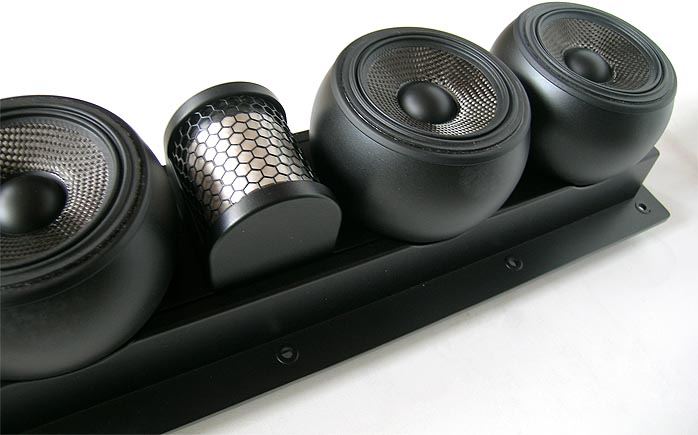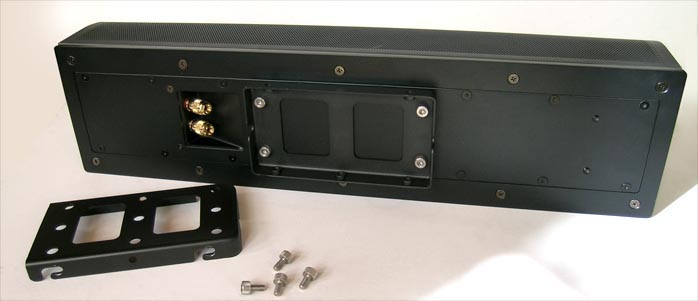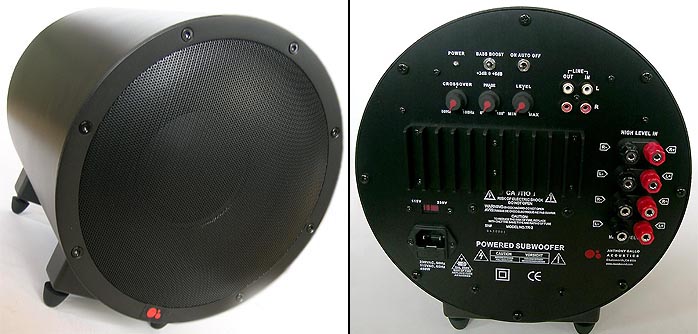|
|
|
|
This review page is supported in part by the sponsor whose ad is displayed above
|
|
|
 |
|
|
 |
|
|
 |
|
|
|
Reviewer: Srajan Ebaen
Source: Cambridge Azur DVD player
Receiver: NAD T751
Speakers: Gallo Acoustics Reference 3; Gallo Acoustics TR-2 subwoofer [on review]
Cables: SilverFi interconnects; HMS Gran Finale speaker cables
Stands: optional Gallo Acoustics stands
Powerline conditioning: Furutech RDP-6
Sundry accessories: none
Room size: 30' w x 18' d x 10' h [sloping ceiling] in long-wall setup in one half, with open adjoining room for a total of ca.1000 squ.ft floor plan
Review Component Retail: $1,199/ea. inclusive of wall mount; $200/ea. for optional low-boy stand
|
|
|
|
|
|
 |
|
 |
Coming soon to your local HiFi Emporium: The new Anthony Gallo Acoustics Reference AV Multimedia and Reference AV Center speakers. Naturally, audio hacks more often than not delight in publishing disagreement over the relative merit of any given component. But occasionally, something hits the scene whose tremors peg the scales no matter who is taking the reading. So it was with the Gallo Reference 3. It won universal acclaim and numerous "Best of Year" and other awards.
Not one to practice ignorance about the veritable rage whereby Plasma screens fly out of stores to find homes with flat-is-phat consumers, Anthony Gallo decided to contribute to the phenomenon. How so? He decided to author a Reference 3 that would sound its best when mounted on the wall.
Impossible, you say. Everyone knows that wall-mounting causes all manner of problems. But then, Mr. Gallo isn't just everyone. While he'd agree that there are major issues if you take a speaker designed for free-air placement and bolt it against the wall, he'd also tell you that if you approach this design challenge head-on and with a dedicated product, common wisdom may turn out to be more stupid than believed.
|
|
| Styled like a sconce with a wrap-around perf grill -- available in all black, all white, all silver (Sony Vega-style) or black with stainless spheres peeking through -- the speaker comes in upright and sideways flavors achieved by rotating the famous CDT² cylindrical diaphragm tweeter. This orientation is fixed at the factory because in center-channel orientation, the |
|
tweeter grows lateral metal skirts to restrict off-axis dispersion. Integral clam-shell wall mounts can be removed to bolt the speaker to an optional stand instead. The included wall-mount hardware suggests that it's not necessary to hit studs. Rather, align the proper half vertically, mark the mounting holes, screw in the drywall receivers, screw in the wall hanger, insert speaker with speaker cable affixed, tighten the bolts and presto - stylish wall sound modeled on the celebrated Ref3.
|
|
 |
|
The geometrical nightmare of a chassis is a custom-cast affair that's as clever as it is apparently simple. Aft, the integral clam shell wall mount comes off entirely. The four vacated holes then connect to the optional stand and raise the speaker about 3 inches off a low boy's top, the customary habitat of Plasma screens when they're not wall-mounted. For the rarely anticipated occasion where a customer may prefer to park the Reference AV on the floor, two additional holes in the cast speaker chassis move the mounting position lower and now raise the speaker about 9.5" off the floor. Chances are, anyone interested in such a setup will opt for the Ref 3. Still, this provision has been included nonetheless.
|
|
 |
|
Matching stands come in black, white and silver-grey and sport four rubber bumpers to protect furniture or floor. A single pair of high-quality 5-way binding posts avoids the need for biwiring with its added expense. The center channel stand sports a narrow-range swivel lock to tilt the driver array upwards if positioned below a television screen.
|
|
|
 |
|
|
Spec'd from 55 to 35,000Hz as a nominal 4-ohm load with 88dB sensitivity, the purely capacitive tweeter hands off mechanically at 3kHz to the two inside spheres. Those run crossover-less and wide open into the bass. At 100Hz, the two outer spheres assist in low-frequency extension and weigh in at 6dB/octave via a solitary low-pass coil.
The speakers ship with a protective foam layer between their perf grilles and drivers. To remove, only undo 8 of the 10 Philips bolts that affix the grill to the chassis. This will be sufficient to pull the foam insert out and redo the bolts.
Wall-mounting naturally benefits the speaker's perceived low-end extension and heft. To increase LF performance, natural mates for the Reference AVs are the company's own TR2 subwoofer [below] or, driven from the Reference 3 SA bass amplifier, one or two of their passive MPS units.
In a 5.1 or 7.1 scenario, two Ref3s with an AV Reference Center and two AV Reference Multimedia units; AVs all around; A'Diva Tis in the rear instead... the current Gallo catalogue is deep enough to make for quite endless mix'n'match scenarios, all encouraged because the designer worked at deliberate timbre matching across the lineup.
|
|
 |
|
 |
|
 |
|
 |
|
The Gallo Reference AV is 25 inches long, 6.5 inches wide and 6.5 inches deep from the wall mount to the apex of the grill. It's easy to imagine the white or silver/grey versions in restaurants, doctor's offices and retail stores where they'd blend completely into the background while promising far better performance than the usual 4" 2-way boxes that are traditionally used in those applications.
Anthony Gallo claims that close wall proximity for once enhances soundstaging - as though the rear wall pushed the sound sideways for wider-than-usual stage width. Because of the physical distance between driver diaphragms and wall surface plus the wide-dispersion tweeter, soundstage depth and focus too are said to be "counter genre". First availability is planned in time for the 2005 Holiday season. My review will focus on the intended multimedia usage. I'll run these speakers in a modest video system context and as close to the wall as feasible. Because ours is a diehard 2-channel music publication, it'll be about concert videos and music, naturally.
|
|
 |
|
|
 |
|
|
 |
|
|
|
|
|
|
|
|
|
|
|